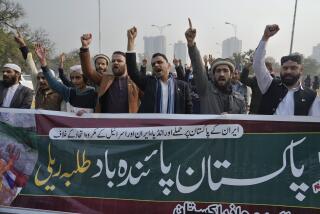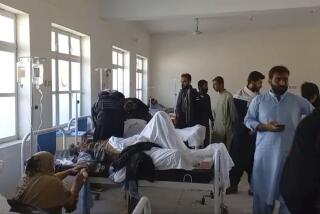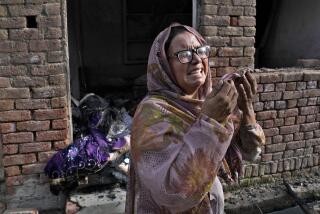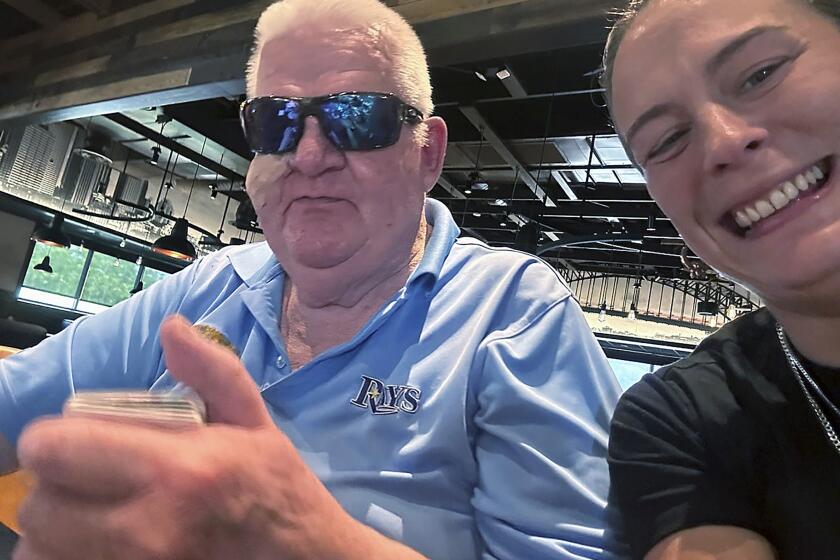Pakistani troops kill radical cleric
ISLAMABAD, PAKISTAN — Elite Pakistani commandos fought their way Tuesday room by room into a heavily fortified radical mosque in the capital’s heart, killing the chief cleric and more than 50 of his armed followers and arresting dozens more. The fate of scores of people thought to have been taken hostage was still unknown early today.
At least eight soldiers died in more than 20 hours of fighting that began before dawn Tuesday and raged through the day and evening before winding down overnight.
But debate was only beginning over whether the battle for Islamabad’s Lal Masjid, or Red Mosque, would prove boon or body blow to the administration of President Pervez Musharraf, whose political standing was already precarious after months of battering by a burgeoning pro-democracy movement.
Analysts say Musharraf’s degree of success in rehabilitating his political image with a forceful stand against Islamic militants will depend in part on the final toll in the mosque conflict; the extent to which the slain cleric, Abdul Rashid Ghazi, is embraced as a martyr; and whether there is a significant backlash from the country’s many extremist Islamist groups, which in the past have proved capable of staging suicide attacks.
“These events could enfeeble or embolden him,” Samir Puri, a defense analyst at Rand Europe, said of Musharraf, an army general who seized power eight years ago. “If he is seen to have been decisive and as having acted in the interests of maintaining law and order, this will emphasize his claim, and the army’s, to being the custodians of the nation.”
The death toll could rise sharply as troops search a labyrinth of rooms, some of them booby-trapped, in the sprawling 2-acre compound. The site carried heavy symbolic weight, given its proximity to the capital’s diplomatic enclave, government ministries and the president’s office.
The assault on the mosque began before dawn with a burst of explosions and gunfire that echoed across Islamabad. Throughout the day, helicopters circled overhead, and armored vehicles and ambulances rumbled to and fro. Sobbing parents of students at two Islamic seminaries inside the compound waited behind barbed-wire barricades for word of their children’s fate.
Ghazi, the chief cleric, had insisted in interviews from inside the besieged mosque that he would die rather than give himself up. He made his last stand in the basement, where military officials said he and his followers used students, including women and boys, as human shields.
Nearly 90 people escaped or were freed in the first hours of the fighting, authorities said. In the days before the compound was stormed, soldiers blew holes in the walls to provide escape routes for hostages. Some students were shot by the militants while trying to flee, the government said.
The standoff, months in the making, erupted July 3 when militants inside fired at Pakistani police. As the siege tightened day by day, Musharraf’s government tried repeatedly to negotiate with the mosque’s militant defenders -- acting out of concern, officials said, for those being held inside against their will, particularly women and children.
Last Wednesday, more than 1,100 people surrendered to authorities, leaving the compound that at one point housed two schools with a combined enrollment of about 5,000 students. Among the departing crowd, Ghazi’s brother and fellow cleric, Abdul Aziz, was caught by police attempting to flee dressed in a woman’s head-to-toe covering, called a burka.
Tuesday’s assault began hours after government negotiators’ final effort to achieve a resolution broke down, with Ghazi demanding unconditional freedom for himself and his followers.
Some of the militants killed and arrested in the fighting were described by authorities as hard-core members of known Pakistani terrorist groups.
Over the months-long standoff, as the cleric brothers sharpened their challenge of Musharraf’s government, “it was natural that the mosque would serve as a magnet for members of terror organizations,” said Rahul Roy-Chaudhury of the International Institute for Strategic Studies in London.
“Even among those [Islamic radicals] who thought the tactics being used at the mosque were somewhat foolhardy, it became a beacon for these groups,” Roy-Chaudhury said.
Resistance from the mosque’s defenders was evidently far tougher than authorities had expected. Early Tuesday, military officials told journalists they expected the takeover would last two or three hours. But late into the night, troops were still battling for control of a final few areas of the compound, including the basement where Ghazi was killed.
The mosque’s militant defenders put up a fierce fight with assault rifles, rocket launchers, firebombs and grenades, and used the minarets as snipers’ nests, Pakistani officials said. But the military said the assault also progressed slowly because troops at times used nonlethal weapons, such as stun grenades, for fear of harming hostages.
Over the last six months, Ghazi and Aziz had instructed followers to embark on a vigilante-style campaign to impose Islamic law, or Sharia, in the capital. At the clerics’ behest, students kidnapped police officers, abducted women they alleged to be prostitutes and harassed owners of video and music stores.
Musharraf was criticized in many quarters for turning a blind eye to militant students’ increasingly provocative actions. A turning point came this month when the students briefly abducted six Chinese nationals who worked in a massage parlor, triggering angry complaints from China, an important Pakistani ally.
While the government’s decision to move against the mosque had widespread public support, protests and calls for vengeance erupted in tribal areas near the Afghan border, which are used by militant groups as a sanctuary, and in some other religiously conservative areas of the country.
The U.S. Embassy in Islamabad urged American citizens to limit their movements in the northwestern city of Peshawar, the main gateway to the tribal areas.
Pakistani authorities, who in recent months have restricted media coverage of protests triggered by Musharraf’s suspension of the country’s reform-minded chief justice, limited journalists’ access to the scene of the fighting, keeping them several hundred yards away. Journalists also were denied access to hospitals where wounded were taken.
Over the last year, as Al Qaeda and the Taliban have regrouped in Pakistan’s tribal areas, Musharraf has come under pressure from the Bush administration to rein in Islamic militants, who are believed to retain close ties to Pakistan’s military intelligence establishment.
Analysts said it was too soon to tell whether the mosque assault presaged a wider crackdown.
“What we’re seeing could be a shift in dealing with religious radicals, but we have to see whether this is duplicated in the tribal areas,” said Roy-Chaudhury, the International Institute for Strategic Studies analyst.
Even though there was broad consensus that the Red Mosque radicals had to be stopped, the public will to confront the militants could be sapped by suicide attacks in cities such as Islamabad, some analysts said.
Pakistan is “a country at war, but a war that is very distant from the elite,” said Puri, the Rand Europe analyst. “It’s one thing to tolerate armed conflict in the ‘Wild West’ of the tribal areas, but quite another thing in their own backyard.”
--
Special correspondent Zaidi reported from Islamabad and Times staff writer King from Istanbul, Turkey.
More to Read
Sign up for Essential California
The most important California stories and recommendations in your inbox every morning.
You may occasionally receive promotional content from the Los Angeles Times.










